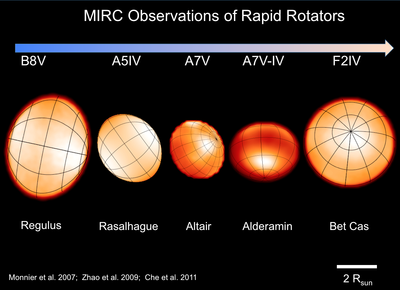A method to study distorted white dwarf stars is developed
The IAA-CSIC is leading a study to determine the properties of stars that, either because of rapid rotation or because they are in a very compact double system subject to strong tidal forces, show a flattened shape
Most stars, due to their rotation and gaseous character, show some flattening at the poles. But some rotate so fast that they take on a distinctly elongated shape, something that also happens in very close binary stars due to mutual attraction. The study of these fast rotators constitutes a theoretical challenge, since they require specific methods to determine their properties. A researcher at the Institute of Astrophysics of Andalusia publishes a study that analyzes, for the first time in a systematic way, the distortions in white dwarf stars, which will allow their radii, masses or temperatures to be determined with greater precision.

White dwarfs are the remains of a star like the Sun that has expelled its outermost layers and retains a very compact nucleus. The densities of these objects can amount to two tons per cubic centimeter, and they can host a mass equivalent to that of the Sun in a volume similar to that of the Earth.
“More and more binary star systems made up of white dwarfs are being found where the stars are highly distorted either by rotational forces, tidal forces, or both. We know, for example, stars that orbit around the common center of mass every few minutes, and that present clearly flattened shapes”, points out Antonio Claret, researcher at the Institute of Astrophysics of Andalusia (IAA-CSIC) who has developed the study.
These binary systems of white dwarfs are an excellent laboratory to deepen our understanding of the evolution of double stars, as well as the physics of tides in astronomical environments or to study gravitational waves, the ripples in the structure of spacetime predicted by Einstein. However, modelling these systems accurately was until now an impossible task.
"These new calculations will make it possible to study these complex systems more rigorously. For example, they will make it possible to distinguish more clearly what the contribution of period shifts due to gravitational wave emission is. They also show that it is necessary to distinguish between hot and cold stars in order to use one model or another to determine their characteristics, including temperature," says Claret (IAA-CSIC).
These binary systems of white dwarfs are an excellent laboratory to deepen our understanding of the evolution of double stars, as well as the physics of tides in astronomical environments or to study gravitational waves, the ripples in the structure of spacetime predicted by Einstein. However, modelling these systems accurately was until now an impossible task.
"These new calculations will make it possible to study these complex systems more rigorously. For example, they will make it possible to distinguish more clearly what the contribution of period shifts due to gravitational wave emission is. They also show that it is necessary to distinguish between hot and cold stars in order to use one model or another to determine their characteristics, including temperature," says Claret (IAA-CSIC).
HOW TO MEASURE THE TEMPERATURE OF FLATTENED STARS
To determine the temperature of deformed stars, the von Zeipel theorem was traditionally used, which proposed that in hot flattened stars -with temperatures of more than 8000 degrees- the temperature is proportional to the local gravity. This introduced the concept of "gravity darkening", which causes the temperature at the poles of a flattened star to be higher than at the equator (in the Sun this effect is barely noticeable due to its low rotation speed).
"The value that von Zeipel assigned to the gravity darkening has been much debated theoretically, and the application of a wrong gravity darkening exponent implies a faulty determination of the star's thermodynamics, which in turn implies obtaining the wrong luminosity, mass and age values," says Antonio Claret (IAA-CSIC).
Antonio Claret developed in 2011 a new formalism to know the gravity darkening from the interior to the atmosphere of stars, and an important conclusion was derived from it: the von Zeipel theorem is only applicable to the deepest regions of the star. Since astrophysicists observe the outermost layers, this new model was the correct alternative to determine the essential parameters of the star with precision.
This new work is a continuation of the previous one, applied to white dwarfs and introducing quantum mechanics calculations. "There are some novel results: for example, we have mathematically related the variation of the specific entropy to the temperature distribution on the surfaces of distorted white dwarfs, and we have also generalised von Zeipel's theorem to the case of very hot white dwarfs. However, such a theorem is still not valid, as demonstrated in 2011, for cold white dwarfs", concludes Claret.
Claret. A. "Rotationally and tidally distorted compact stars. A theoretical approach to the gravity-darkening exponents for white dwarfs". Astronomy & Astrophysics, April 2021.
Instituto de Astrofísica de Andalucía (IAA-CSIC)
Unidad de Divulgación y Comunicación
Silbia López de Lacalle - sll[arroba]iaa.es - 958230676
https://www.iaa.csic.es
https://divulgacion.iaa.csic.es

